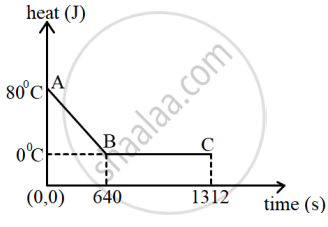Advertisements
Advertisements
Question
The diagram below shows a cooling curve for 200 g of water. The heat is extracted at the rate of 100 Js-1. Answer the questions that follow:

- Calculate specific heat capacity of water.
- Heat released in the region BC.
Solution
(a) mass of water (m) = 200 g = 0.2 kg.
Rate of heat extraction= 100 J/s.
So, total heat extracted for curve AB is = 100 × 640 = 64000 J
Now, for curve AB we can write,
64000 = 0.2 × Cp × (353 - 273) ...`[(80^circ "C" = 273 + 80 = 353;),(0^circ "C" = 273 + 0 = 273 "K")]`
Solving we get,
C = 4000 Jkg-1 K-1
Thus, the specific heat capacity of water is 4000 Jkg-1 K-1.
(b) From the figure it is clear that at point Band C is corresponds to time 640 sand 1312 s, respectively. Thus, heat released in region BC is = 100 × (1312 - 640) = 67,200 J
APPEARS IN
RELATED QUESTIONS
A copper vessel of mass 100 g contains 150 g of water at 50°C. How much ice is needed to cool it to 5°C?
Given: Specific heat capacity of copper = 0.4 Jg-1 °C-1
The Specific heat capacity of water = 4.2 Jg-1 °C-1
The Specific latent heat of fusion ice = 336 Jg-1
A mass m1 of a substance of specific heat capacity c1 at temperature t1 is mixed with a mass m2 of other substance of specific heat capacity c2 at a lower temperature t2. Deduce the expression for the temperature t of the mixture. State the assumption made, if any.
Explain the term boiling ?
What is meant by global warming?
What is carbon tax?
What are other units of heat? Name and define them.
Discuss how high specific heat capacity of water helps in formation of land and sea breeze.
Will the value of specific heat’capacity and specific latent heat of a substance change if the scale is °F instead of °C?
An office room contains about 4000 moles of air. The change in the internal energy of this much air when it is cooled from 34° C to 19° C at a constant pressure of 1.0 atm is (Use `gamma_"air"` = 1.4 and Universal gas constant = 8.314 J / mol K) ____________.
